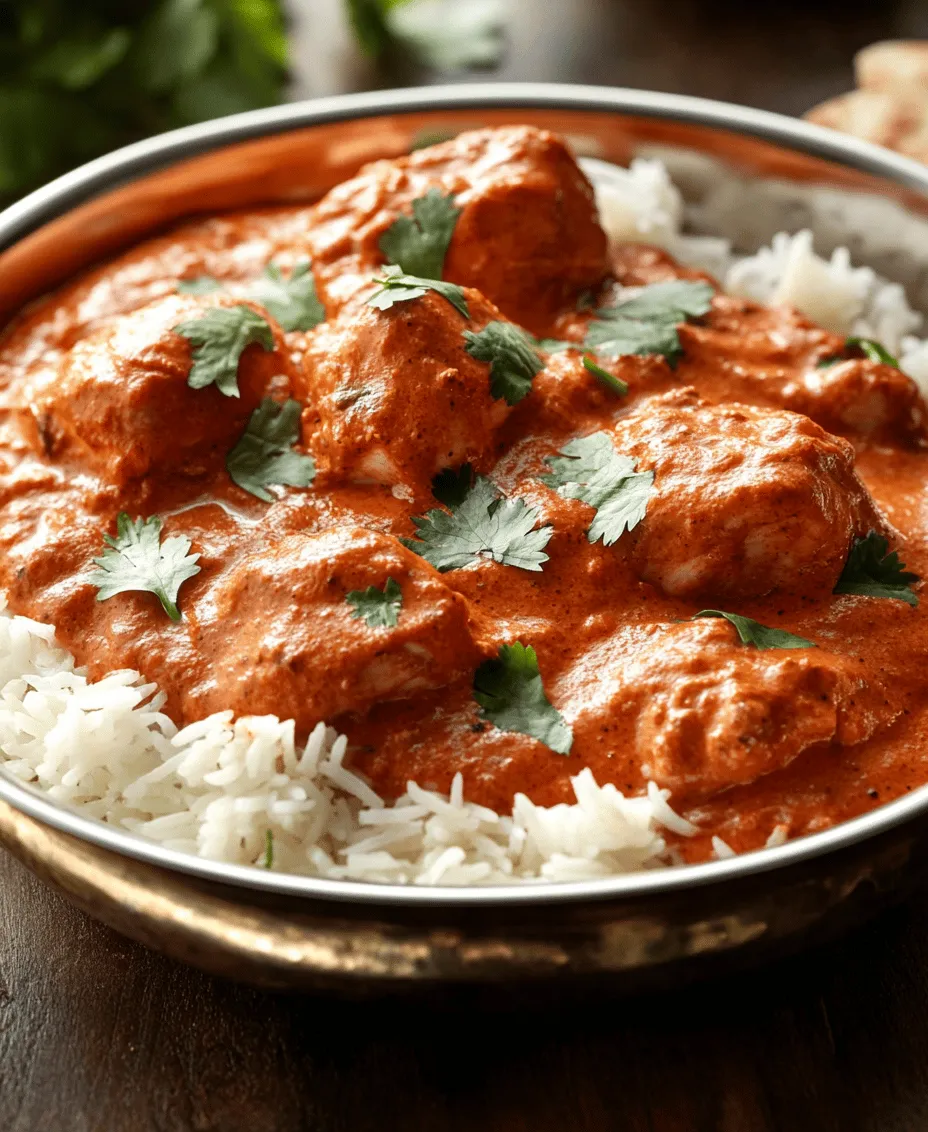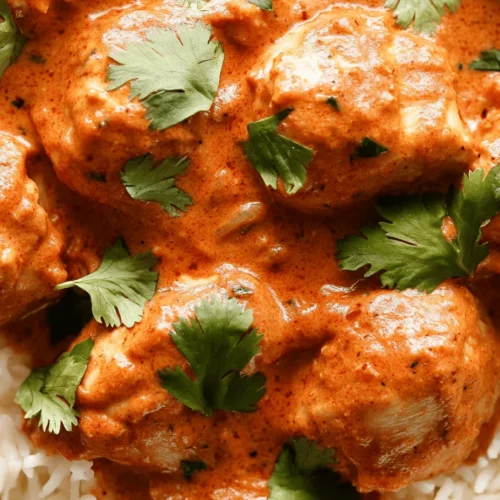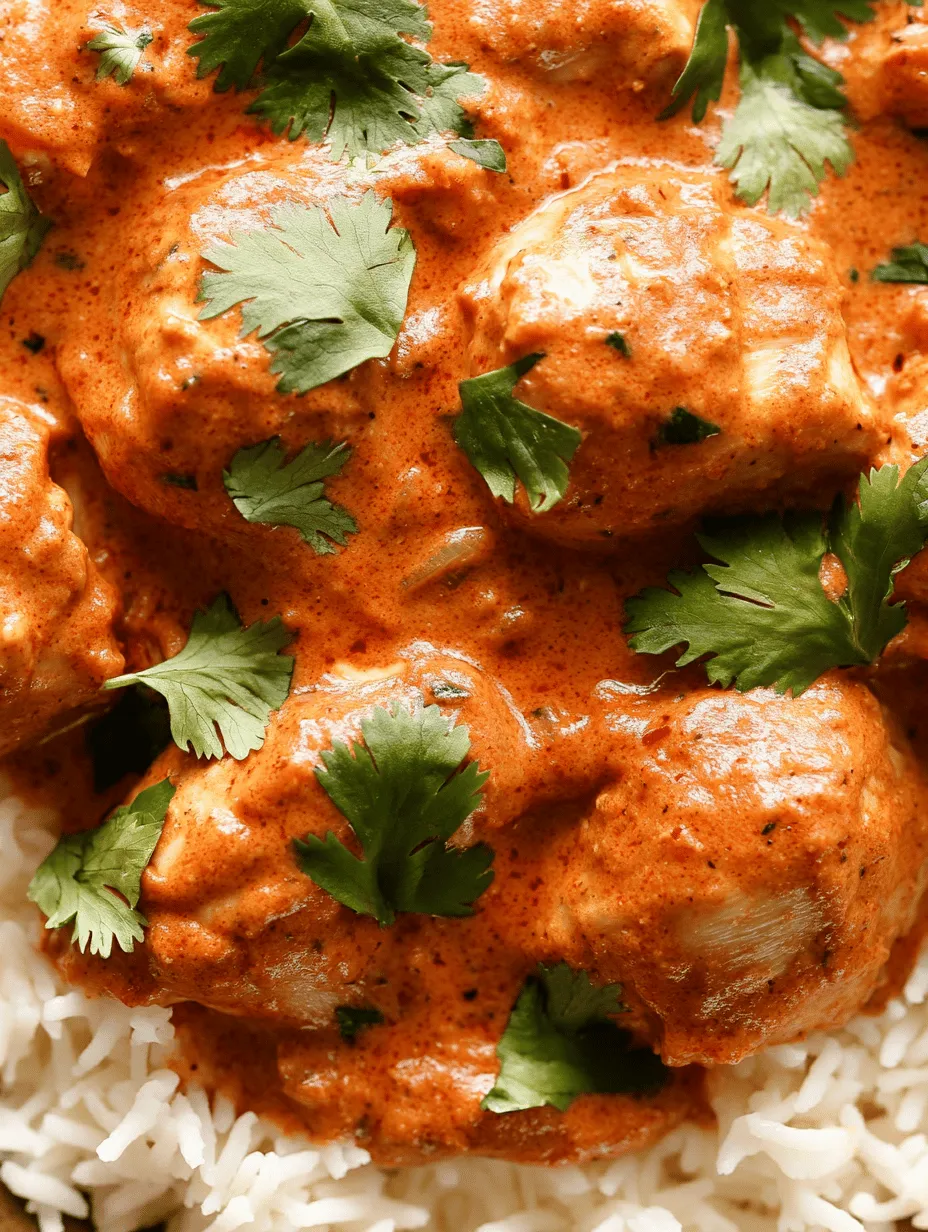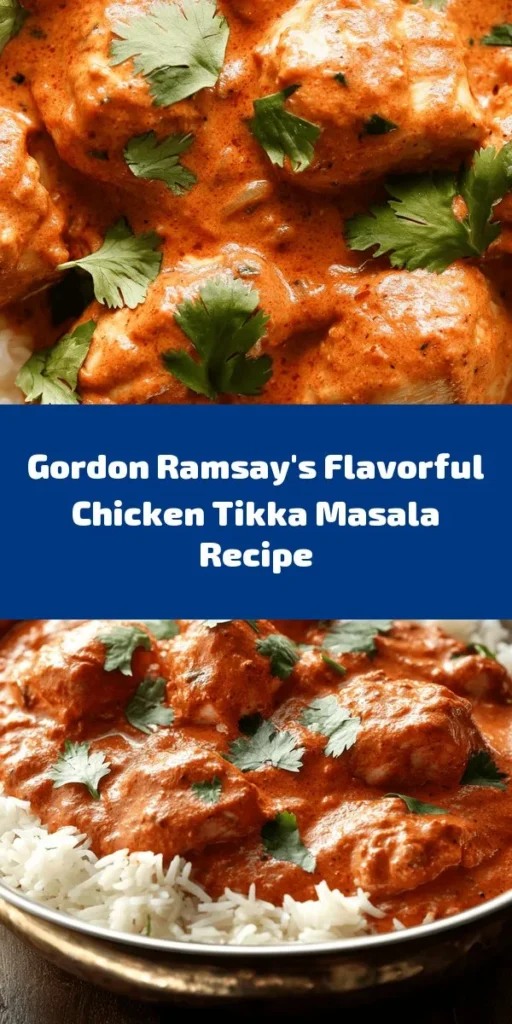Introduction
Chicken Tikka Masala is a dish that has captured the hearts and palates of food enthusiasts around the world. Known for its vibrant orange sauce and succulent pieces of marinated chicken, this dish offers a perfect balance of spices, creaminess, and warmth. Its popularity has soared over the years, making it a staple in Indian restaurants and homes alike.
Among the many chefs who have embraced and elevated this classic recipe, Gordon Ramsay stands out with his unique approach to Chicken Tikka Masala. Known for his high culinary standards and innovative techniques, Ramsay infuses his version of this beloved dish with authenticity, depth, and a touch of modern flair. For home cooks eager to replicate the authentic flavors of Indian cuisine, this recipe serves as an excellent guide, combining traditional methods with contemporary cooking practices.
In this article, we will take a deep dive into Gordon Ramsay’s Chicken Tikka Masala, exploring its historical roots, the essential ingredients that make it shine, and the crucial steps that ensure a burst of flavor in every bite.
Understanding Chicken Tikka Masala
Historical Background of Chicken Tikka Masala
The origins of Chicken Tikka Masala are often debated, with some attributing its creation to Indian cooks in the UK during the 1960s. It is believed that the dish was born out of the need to cater to Western tastes while still retaining the essence of Indian flavors. The dish combines marinated, grilled chicken (tikka) with a creamy tomato-based sauce, making it a perfect fusion of cultures.
While some claim that Chicken Tikka Masala is a British invention, its roots can be traced back to traditional Indian cooking, where marinated meats are a common feature. The use of rich, spiced sauces is integral to Indian cuisine, and Chicken Tikka Masala exemplifies this beautifully. Over the years, it has evolved into a global sensation, with variations appearing in countless regions, each adding its unique twist to the classic recipe.
The Dish’s Significance in Indian Cuisine and Its Global Influence
In India, chicken tikka is often served as an appetizer, marinated in spices and yogurt before being cooked in a tandoor (traditional clay oven). However, when transformed into Chicken Tikka Masala, it becomes a hearty main dish, suitable for pairing with naan or rice. The dish’s significance lies not only in its flavor but also in its ability to bring people together, whether at family gatherings or festive occasions.
Globally, Chicken Tikka Masala has become synonymous with Indian cuisine, frequently appearing on restaurant menus and in home kitchens alike. Its wide appeal is attributed to its mild spice levels, which can be adjusted to suit different palates. This versatility has solidified its place as a comfort food for many, transcending cultural boundaries and uniting food lovers everywhere.
Variations of Chicken Tikka Masala Across Different Cultures
While the core components of Chicken Tikka Masala remain consistent—marinated chicken and a spiced tomato sauce—various cultures have embraced the dish, leading to fascinating adaptations. In the UK, you might find it served with a side of chips or rice, reflecting local dining customs. In India, some variations incorporate coconut milk for a sweeter, creamier sauce, particularly in coastal regions.
The dish has also inspired chefs to experiment with different proteins, including lamb, paneer, or even tofu for a vegetarian take. Each culture adds its unique flair, demonstrating how adaptable and beloved Chicken Tikka Masala truly is.
Ingredients Breakdown
To create Gordon Ramsay’s Chicken Tikka Masala, understanding the essential ingredients is key. Each component contributes to the dish’s overall flavor profile and texture, ensuring a delicious result.
Overview of Essential Ingredients in Gordon Ramsay’s Recipe
1. Chicken Thighs: Ramsay favors chicken thighs over breasts due to their richer flavor and juiciness. The fat content in thighs helps keep the meat tender during cooking.
2. Yogurt: A cornerstone of the marinade, yogurt not only tenderizes the chicken but also adds a subtle tanginess that complements the spices.
3. Spices: A blend of spices, including cumin, coriander, turmeric, garam masala, and chili powder, creates the signature flavor of the dish. Each spice adds its unique note, contributing to the depth of the sauce.
4. Tomatoes: Canned or fresh tomatoes serve as the base for the sauce, providing a sweet and tangy foundation that balances the spices.
5. Cream: To finish the sauce, heavy cream is added, enriching the dish and creating a luxurious texture that coats the chicken beautifully.
6. Onions and Garlic: These aromatics are essential for building flavor in the sauce, providing a savory backbone that enhances each bite.
7. Fresh Cilantro: Used as a garnish, fresh cilantro adds a burst of color and a fresh, herbaceous note to the dish.
Importance of Each Ingredient in Contributing to Flavor and Texture
The harmony of flavors in Chicken Tikka Masala is a result of each ingredient playing its role. The chicken provides the main protein, while yogurt helps to lock in moisture and flavor during the marination process. The spices are what make the dish truly special, transforming the chicken into a vibrant culinary experience.
Tomatoes add acidity and balance, while cream rounds out the flavors, giving the sauce a velvety finish. Onions and garlic bring a deep, aromatic quality, making the entire dish more enticing. Finally, the cilantro not only enhances the visual appeal but also adds a refreshing note that cuts through the richness of the sauce.
Fresh vs. Dried Spices: Why Quality Matters
When it comes to spices, freshness is crucial. Freshly ground spices release essential oils that provide more robust flavor compared to their dried counterparts. For the best results, consider purchasing whole spices and grinding them just before use. This small step can elevate the dish significantly, ensuring that each bite is bursting with authentic flavor.
In addition to using fresh spices, it’s essential to pay attention to the quality of your ingredients. Opt for high-quality yogurt, ripe tomatoes, and organic chicken whenever possible. These choices not only enhance the taste but also contribute to a healthier meal.
The Marinade: Key to Flavorful Chicken
The marinade is arguably the most important step in making Chicken Tikka Masala. It infuses the chicken with flavor, ensuring that every piece is succulent and delicious.
Significance of Marinating Chicken
Marinating chicken serves multiple purposes. It tenderizes the meat, allowing it to soak up the flavors of the spices and yogurt, while also creating a flavorful crust when cooked. The acid in the yogurt helps to break down proteins, resulting in tender, juicy chicken that is packed with flavor.
Detailed Explanation of the Marinade Ingredients
Gordon Ramsay’s marinade features a blend of yogurt, spices, lemon juice, and salt. Each component plays a vital role in the marination process:
– Yogurt: As mentioned, it tenderizes the chicken and adds a tangy flavor.
– Spices: The same spices used in the sauce—cumin, coriander, turmeric, garam masala, and chili powder—are mixed into the marinade, ensuring the chicken is flavorful inside and out.
– Lemon Juice: This adds acidity, which brightens the overall flavor and further tenderizes the meat.
– Salt: Essential for seasoning, salt enhances the flavors and ensures that the chicken is well-seasoned.
Step-by-Step Process of Marinating Chicken for Optimal Flavor
1. Prepare the Marinade: In a large bowl, combine yogurt, lemon juice, and all the spices. Whisk until well mixed.
2. Add the Chicken: Cut the chicken thighs into bite-sized pieces and add them to the marinade. Ensure each piece is well-coated.
3. Marinate: Cover the bowl with plastic wrap and refrigerate for at least 1 hour, but ideally overnight. This allows the flavors to penetrate the meat thoroughly.
4. Bring to Room Temperature: Before cooking, remove the chicken from the refrigerator and let it sit at room temperature for about 30 minutes. This ensures even cooking.
By following these steps, you will create a flavorful marinade that guarantees tender, spiced chicken, ready to shine in your Chicken Tikka Masala.
Cooking the Chicken: Techniques and Tips
Once the chicken has marinated to perfection, it’s time to cook it. Gordon Ramsay offers different options for cooking the chicken, each with its unique benefits.
Discuss Options: Grilling vs. Skillet Cooking
1. Grilling: For an authentic touch, grilling the marinated chicken on a barbecue or grill pan adds a smoky flavor and char that enhances the dish. The high heat helps to caramelize the marinade, creating a delicious crust while keeping the inside juicy.
2. Skillet Cooking: If grilling isn’t an option, cooking the chicken in a skillet or frying pan is equally effective. Use a bit of oil to ensure the chicken doesn’t stick and to achieve a nice sear.
Both methods offer excellent results, so choose whichever option suits your kitchen setup.
Importance of Cooking Time and Temperature for Juicy Chicken
No matter which cooking method you choose, it’s essential to monitor the cooking time and temperature. Chicken should be cooked to an internal temperature of 165°F (75°C) to ensure it is safe to eat. Overcooking can lead to dry, tough chicken, so keep a close eye on it.
For grilling, cook the chicken for about 6-8 minutes on each side, depending on the thickness of the pieces. For skillet cooking, aim for a similar cooking time, adjusting as needed based on your stove’s heat output.
With these techniques and tips, your Chicken Tikka Masala will not only be flavorful but also perfectly cooked, ensuring a delightful dining experience.
In the next part of this article, we will delve into the process of creating the rich and creamy sauce that makes Gordon Ramsay’s Chicken Tikka Masala truly unforgettable. Stay tuned for the continuation of this flavorful journey into Indian cuisine.

How to Achieve the Perfect Char—Tips for Grilling or Pan-Searing
To create that authentic flavor profile synonymous with Gordon Ramsay’s Chicken Tikka Masala, it’s essential to achieve the perfect char on your chicken. Whether you choose to grill or pan-sear, the goal is to develop a deep, smoky flavor that complements the rich sauce.
Grilling Tips:
1. Preheat Your Grill: Ensure your grill is hot before placing the chicken on it. A high temperature helps create those beautiful grill marks and locks in moisture.
2. Oil the Grill Grates: Prevent sticking by brushing the grates with oil. This also enhances the charred flavor.
3. Marinate Properly: Allow the chicken to marinate for at least an hour, but overnight is best. This not only infuses flavor but also tenderizes the meat.
4. Use Indirect Heat: If your grill has multiple burners, consider searing the chicken over direct heat to get those grill marks, then move it to indirect heat to finish cooking through without burning.
Pan-Searing Tips:
1. Choose the Right Pan: A heavy-bottomed skillet or cast-iron pan provides even heat and better browning.
2. Heat the Pan: Make sure the pan is hot before adding the chicken. A drop of water should sizzle and evaporate immediately.
3. Don’t Overcrowd the Pan: Cook in batches if necessary. Overcrowding lowers the temperature of the pan, leading to steaming rather than searing.
4. Baste for Flavor: If using oil or butter, consider basting the chicken as it cooks. This technique adds flavor and helps achieve a golden crust.
Crafting the Sauce: From Simmer to Savor
The sauce is the heart of Chicken Tikka Masala, transforming your marinated chicken into a vibrant dish bursting with flavor. Follow these steps to master the sauce.
Step-by-Step Process of Preparing the Sauce:
1. Sauté Onions: Begin by heating oil in a large pan over medium heat. Add finely chopped onions and cook until golden brown. This step builds the base of flavor for your sauce.
2. Add Garlic and Ginger: Once the onions are caramelized, stir in minced garlic and grated ginger. Sauté for another minute until fragrant, ensuring not to burn them.
3. Tomatoes and Spices: Add crushed tomatoes along with the spices—cumin, coriander, turmeric, garam masala, and chili powder. Cook this mixture until the tomatoes break down and the spices are fragrant.
4. Creamy Finish: Lower the heat and stir in heavy cream. This not only enhances the sauce’s richness but also balances the spices. Allow it to simmer gently, adjusting the consistency with a bit of water if needed.
The Role of Onions, Tomatoes, and Cream in the Sauce:
– Onions provide sweetness and depth, forming the foundation of the sauce.
– Tomatoes contribute acidity and sweetness, balancing the spices while enhancing the dish’s overall flavor profile.
– Cream adds a luxurious texture, making the sauce rich and indulgent while smoothing out the spice notes.
Techniques for Perfecting the Sauce Texture and Flavor Balance:
– Simmering: Allow the sauce to simmer for at least 15-20 minutes. This helps meld the flavors together and creates a luscious texture.
– Taste and Adjust: Always taste your sauce before serving. Adjust seasoning with salt, sugar, or additional spices to achieve a balanced flavor profile.
Combining the Elements: Marrying Chicken and Sauce
The final step in creating Gordon Ramsay’s Chicken Tikka Masala is to marry your perfectly charred chicken with the rich sauce. Timing and seasoning are crucial here.
Importance of Timing in Combining Chicken and Sauce:
– Add Cooked Chicken to Sauce: Once the chicken is cooked and has a lovely char, add it to the simmering sauce. This allows the chicken to absorb the flavors without overcooking.
– Final Simmer: Let the chicken simmer in the sauce for an additional 5-10 minutes. This final simmer melds the flavors beautifully and ensures the chicken is warmed through.
How to Adjust Seasoning for a Balanced Dish:
– Taste Test: After simmering, taste the dish again. You might find it needs a pinch more salt, a dash of acidity from lemon juice, or a hint of sweetness to balance out the spices.
– Herbs for Freshness: Adding fresh cilantro or mint right before serving can brighten the dish and add a fresh flavor contrast.
Serving Suggestions
The presentation of your Chicken Tikka Masala enhances the dining experience. Serve this dish in style with the following suggestions.
Traditional Accompaniments: Basmati Rice and Naan
– Basmati Rice: Fluffy, fragrant basmati rice is the classic accompaniment to soak up the rich sauce. Consider cooking the rice with a bay leaf, cardamom, or saffron for added flavor.
– Naan Bread: Soft, pillowy naan is perfect for scooping up the chicken and sauce. You can make it at home or purchase it from a local Indian restaurant.
Ideas for Garnishing for Presentation:
– Chopped Cilantro: A sprinkle of fresh chopped cilantro adds a pop of color and freshness.
– Cream Drizzle: A swirl of cream on top of the dish can elevate the visual appeal and indicate the dish’s richness.
– Lemon Wedges: Serve with lemon wedges for a bright touch that guests can squeeze over their plates for added acidity.
Pairing Recommendations: Side Dishes and Beverages
– Side Dishes: Consider serving vegetable samosas, a tangy cucumber salad, or a refreshing raita to balance the richness of the main dish.
– Beverages: Pair your Chicken Tikka Masala with a chilled glass of Riesling or a light lager beer. The sweetness in these beverages complements the spices beautifully.
Nutritional Considerations
When indulging in Chicken Tikka Masala, it’s essential to be mindful of the nutritional profile and consider healthier alternatives.
Breakdown of Nutritional Content per Serving:
– Calories: Approximately 400-500 calories per serving, depending on the amount of cream and chicken used.
– Protein: Chicken is a great source of lean protein, providing about 30 grams per serving.
– Carbohydrates: When served with basmati rice, the dish can contain around 60 grams of carbs.
Healthier Alternatives for Certain Ingredients:
– Low-Fat Cream: Substitute heavy cream with low-fat yogurt or coconut milk for a lighter version while maintaining creaminess.
– Chicken Alternatives: For a leaner option, consider using chicken breast instead of thighs or substituting with tofu for a vegetarian version.
Adjustments for Dietary Restrictions:
– Gluten-Free Options: Use gluten-free naan or serve with rice instead.
– Dairy-Free Options: Replace cream with cashew cream or coconut cream to keep the dish creamy without dairy.
Conclusion
Making Gordon Ramsay’s Chicken Tikka Masala at home is not just about following a recipe; it’s about embracing the joy of cooking and exploring the rich tapestry of Indian cuisine. This dish embodies comfort food with its aromatic spices and creamy texture, making it a favorite for many.
With its versatility, you can customize the level of spice and richness to suit your personal taste. Whether you enjoy it with traditional basmati rice and naan or opt for healthier alternatives, this Chicken Tikka Masala is sure to impress family and friends alike.
Embarking on this culinary journey will also encourage you to explore more Indian dishes, each with its unique flavors and techniques. So, gather your ingredients, follow the steps, and savor the delightful experience of cooking and sharing this iconic dish.



